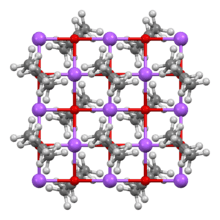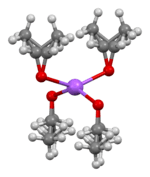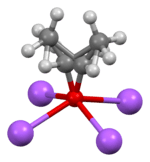Sodium ethoxide
Sodium ethoxide is the organic compound with the formula C2H5ONa. It is a white solid, although impure samples appear yellow or brown. It dissolves in polar solvents such as ethanol. It is commonly used as a strong base.[2]
 | |
| Names | |
|---|---|
| IUPAC name
Sodium ethoxide | |
| Other names
Sodium ethanolate, sodium ethylate (obsolete) | |
| Identifiers | |
CAS Number |
|
3D model (JSmol) |
|
Beilstein Reference |
3593646 |
| ChEBI | |
| ChemSpider | |
| ECHA InfoCard | 100.004.989 |
| EC Number |
|
PubChem CID |
|
| UNII | |
CompTox Dashboard (EPA) |
|
InChI
| |
SMILES
| |
| Properties | |
Chemical formula |
C2H5ONa |
| Molar mass | 68.05 g/mol |
| Appearance | white hygroscopic |
| Density | 0.868 g/cm^3 (of a 21 wt% solution in ethanol) |
| Melting point | 260 °C (500 °F; 533 K) |
Solubility in water |
Reacts |
| Solubility | ethanol and methanol |
| Acidity (pKa) | 15.5[1] |
| Hazards | |
| Safety data sheet | Oxford MSDS |
| GHS pictograms |    |
| GHS Signal word | Danger |
GHS hazard statements |
H228, H251, H302, H314, H318 |
GHS precautionary statements |
P210, P235+410, P240, P241, P260, P264, P270, P280, P301+312, P301+330+331, P303+361+353, P304+340, P305+351+338, P310, P321, P330, P363, P370+378, P405, P407, P413, P420, P501 |
| NFPA 704 (fire diamond) | 
2
2
1 |
Except where otherwise noted, data are given for materials in their standard state (at 25 °C [77 °F], 100 kPa). | |
| Infobox references | |
Preparation
Few procedures have been reported to the anhydrous solid. Instead the material is typically prepared in a solution with ethanol. It is commercially available and as a solution in ethanol. It is easily prepared in the laboratory by treating sodium metal with absolute ethanol:[3]
- 2 C2H5OH + 2 Na → 2 C2H5ONa + H2
An alternative, cheaper route involves the reaction of sodium hydroxide with anhydrous ethanol. This reaction suffers from incomplete conversion to the alkoxide, but for less stringent applications, full conversion is unimportant.
Structure
The crystal structure of sodium ethoxide has been determined by X-ray crystallography. It consists of layers of alternating Na+ and O− centres with disordered ethyl groups covering the top and bottom of each layer. The ethyl layers pack back-to-back resulting in a lamellar structure. The reaction of sodium and ethanol sometimes forms other products such as the disolvate NaOEt·2EtOH. Its crystal structure has been determined, although the structure of other phases in the Na/EtOH system remain unknown.[4]
 |  |  |
in the crystal structure of NaOEt |
Reactions
Solid samples of sodium ethoxide gradually turn dark on storage in dry air because of oxidation.[5] In moist air, it hydrolyzes rapidly to sodium hydroxide. The conversion is not obvious and typical samples of NaOEt are contaminated with NaOH.
Sodium ethoxide is commonly used as a base in the Claisen condensation[6] and malonic ester synthesis[7]. Sodium ethoxide may either deprotonate the α-position of an ester molecule, forming an enolate, or the ester molecule may undergo a nucleophilic substitution called transesterification. If the starting material is an ethyl ester, trans-esterification is irrelevant since the product is identical to the starting material. In practice, the alcohol/alkoxide solvating mixture must match the alkoxy components of the reacting esters to minimize the number of different products.
Many alkoxides are prepared by salt metathesis from sodium ethoxide.
Safety
Sodium ethoxide is a strong base, and is therefore corrosive.
See also
- Alkoxide
References
- disassociation constant of ethanol, referenced in the CRC Handbook of Chemistry and Physics 87th edition.
- K. Sinclair Whitaker, D. Todd Whitaker, "Sodium Ethoxide" Encyclopedia of Reagents for Organic Synthesis 2001.doi:10.1002/047084289X.rs070
- C. S. Marvel and E. E. Dreger (1926). "Ethyl Acetopyruvate". Organic Syntheses. 6: 40.; Collective Volume, 1, p. 328
- M. Beske, L. Tapmeyer, M. U. Schmidt (2020). "Crystal structure of sodium ethoxide (C2H5ONa), unravelled after 180 years". Chem. Commun. 56: 3520–3523. doi:10.1039/C9CC08907A.CS1 maint: uses authors parameter (link)
- M. Eagleson "Concise encyclopedia chemistry" p.997.
- Clayden, Jonathan; Greeves, Nick; Warren, Stuart (2012). Organic chemistry (2nd ed.). New York: Oxford University Press. p. 645. ISBN 978-0-19-927029-3.
- Wang, Zerong (15 September 2010). Comprehensive organic name reactions and reagents. John Wiley. pp. 1811–1815. ISBN 9780471704508.